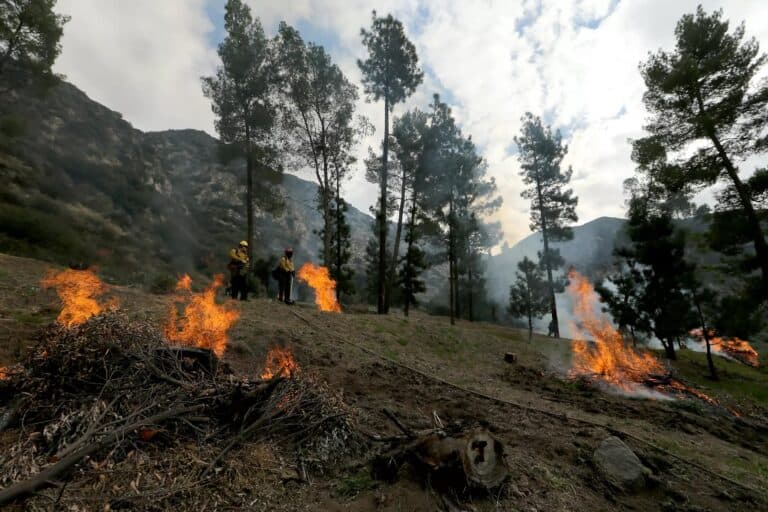U.S. Forest Service firefighters in the Angeles National Forest burn piles of forest debris below Mt. Baldy in November 2023. Controlled burns are part of the service’s forest management practices. (Luis Sinco / Los Angeles Times)
California has unveiled an ambitious plan to help combat the worsening climate crisis with one of its invaluable assets: its land.
Over the next 20 years, the state will work to transform more than half of its 100 million acres into multi-benefit landscapes that can absorb more carbon than they release, officials announced Monday. The so-called nature-based solutions will span natural and working lands such as forests, farms, grasslands, chaparral, deserts and other types of ecosystems and urban environments.
The first-of-its-kind plan — part of Gov. Gavin Newsom’s California Climate Commitment geared toward helping the state reach carbon neutrality by 2045 — includes 81 targets that will help harness the power of millions of acres across the Golden State.
“We’re setting aggressive and ambitious new targets to use California’s lands to fight the climate crisis,” Newsom said in a statement. “This scale of action is unprecedented, and yet another example of California punching above its weight. From restoring and conserving lands to greening our urban spaces and treating more acres to prevent wildfires, we’re protecting nature and allowing it to work for our communities.”

Among the 2045 targets announced Monday are 33.5 million acres that will be managed to reduce wildfire risk, mostly through fuel reduction activities and beneficial fire practices. Those practices include cultural and prescribed burns, which are intentional fires designed to sear through overgrown vegetation and other material that can act as fuel for flames.
To get there, the state seeks to conduct 1.5 million acres of wildfire risk reduction activity per year by 2030; 2 million acres per year by 2038, and 2.5 million acres per year by 2045, most of which will be applied to forests, shrublands, chaparral and grasslands, which together comprise about 67% of the state.
(By comparison, the California Department of Forestry and Fire Protection completed about 105,000 acres of fuel treatment, including 36,000 acres of prescribed burns during the 2023 fiscal year, according to agency data. The U.S. Forest Service completed about 312,000 acres of combined treatment and burns).
The plan also calls for 11.9 million acres of forestland to be managed for biodiversity protection, carbon storage and water supply protection by 2045, and 2.7 million acres of shrublands and chaparral to be managed for carbon storage, resilience and habitat connectivity, among other efforts.
“We’ve had a really strong environmental conservation movement in California, and we’re clearly strong on climate action, but we haven’t integrated nature into our climate agenda,” said Wade Crowfoot, California’s natural resources secretary. “And so this is really the next tangible step to do that.”
Crowfoot noted that nature-based solutions are gaining attention not only in the state, but also on the international stage, with the Intergovernmental Panel on Climate Change validating their critical importance in ongoing efforts to stabilize the climate.
“This is all about improving the health and the resilience of our lands, whether that’s forests and deserts and farms and coastal areas,” Crowfoot said. “Healthy, resilient lands … do a better job absorbing and storing carbon, and avoid emissions.”
But the move was also prompted by the results of California’s 2022 Scoping Plan for Achieving Carbon Neutrality, which analyzed for the first time the […]
Full article: www.latimes.com

